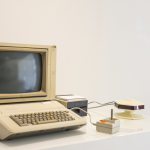Cast your mind back to the 1990s. Now, check your pockets. What have you got in there? A calculator. A camera. A voice recorder. Possibly also a ‘mobile’ phone. A million associated peripherals. Nowadays, we carry all these pieces of technology in a single, slim device. We’ve taken a bunch of features and moved them onto a single platform. This is the defining idea behind multi-platform software: taking features that we’re familiar with, and maintaining a consistent experience of using them across devices. It’s happening all over the tech world. We’ll give you an overview of the current operating system field – Windows 8, BlackBerry 10, iOS and OS X, Android – and suggest where each multi-platform ethos is headed.
Windows
Around a year ago, someone poked the slumbering Microsoft machine. When it awoke, it discovered that the monopolistic market position it held in the nineties had been eroded by better, riskier innovation. As quickly as it could, Redmond began establishing itself in the lucrative mobile arena: an area it had almost entirely ignored until then. The idea obviously caught hold, because Microsoft’s love affair with mobile technology manifested itself in Windows 8, the company’s first cross-platform operating system. It was bold, different and unexpected, which is why people bought it. It said “why should a desktop computer work any different to a tablet, a mobile phone, a TV, or a fridge?”. Later on, when everyone realised that there were very good reasons why these things should work differently, they stuck the old Windows 7 desktop back in. So Windows is now a hybrid OS, stuck somewhere between future-facing touch-friendliness and ‘ancestor-aware’ mouse and keyboard interaction. In 2011, they showed us a vision of a future where everything ran Windows, and nobody seemed to mind, but that seems a little distant right now.
BlackBerry
Gently trundling into the touchscreen future came BlackBerry. BlackBerry 10 launched in January 2013, and was a significant overhaul of the previous incarnation of every businessman’s favourite operating system. It introduced gestures from all parts of the screen, making use of areas previously uncharted by enquiring thumbs. It introduced true multitasking and split-screening, and a coherent interaction paradigm across tablets and mobile devices. BlackBerry 10 is an impressive piece of work, because it picks and chooses its feature set from other mobile operating systems, building on them where necessary.
iOS and OS X
Apple’s decision to maintain the separation of their operating systems for mobile – iOS – and desktop – OS X – has been duly questioned by many tech critics. Those hoping to see a Windows-esque cross-device environment will have to console themselves that Apple rarely hits the trail first, but rather waits patiently for the technological pieces to slot into place before hitting the market hard (usually among spurious claims that they invented everything they’re building on). For now, Apple is content to bring popular iOS features to OS X – encouraging multi-platform software, not demanding it – but more future-minded critics would quite like to see that working the other way, too.
Android
Android’s future lies in its open-source roots. Because it’s so easy to dig into the Java-esque source code and doctor your own, bespoke OS, many manufacturers are jumping aboard the Android bandwagon. Android, though, is a mobile-first experience. Although you can pick up Android laptops – and even desktops – they’re far from ideal. Don’t expect a seamless cross-platform experience from Android any time soon.











Leave a Reply